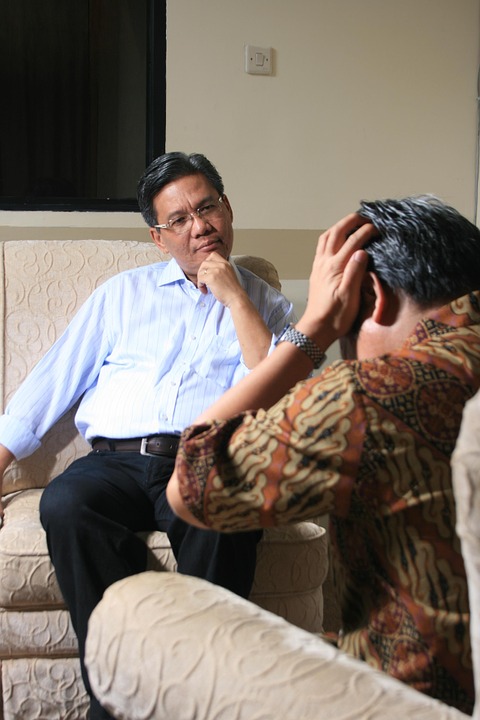Caregivers can benefit by understanding a patient’s pain without feeling it themselves.When Allison Basinger got back to her office, she lay down on the floor, as though she’d suffered a migraine or toughed out a marathon.…By Jamil Zaki
When Allison Basinger got back to her office, she lay down on the floor, as though she’d suffered a migraine or toughed out a marathon. In fact, she had just finished a session with SAFEHOME, a Kansas City-area organization that supports teenage survivors of domestic violence. Under its auspices, Allison visited local middle and high schools to educate students about unhealthy relationships and teen dating violence. That day, like many others, a student had come forward with a horrific story of her own abuse, and Allison had done what she could to help. Afterward, lying there, she returned to her own struggle, one that many people in her line of work share. Once you open yourself to the suffering of others, it can feel impossible to turn off their pain.
Following a disaster, it’s easy to pick out firefighters, police officers, and EMTs: They are the ones running toward the resulting chaos while everyone else runs away. Helping professionals—in fields such as social work, psychotherapy, and hospice care—are the emotional counterparts to first responders, gravitating toward experiences the rest of us avoid. Basinger, for one, felt the pull within weeks of starting work at SAFEHOME. A deeply religious person, she had struggled to understand her own suffering, which included an abusive relationship and bullying severe enough for her to switch schools. SAFEHOME gave it a purpose: She could prevent the pain of her past from invading others’ futures. As she puts it, “You want to rescue them from going through those things for the first time.” Her experience is not uncommon. Surveys of career helpers find they are more likely to report family histories of abuse or substance dependence than professionals in finance, music, and science.
Patients thrive from emotional connection with nurses, social workers, and therapists, but helpers who provide this connection can wilt under its force. The stress of caring can lead to astonishing levels of job turnover. According to one review, 30 to 60 percent of social workers in high-impact sectors, such as child abuse, leave their jobs each year. When caregivers flame out at such rates, it opens cracks in the continuity of care, through which patients frequently fall. Even helpers who do stay often harden themselves to their patients’ emotions. Medical students report lower levels of empathy as their training progresses. Health-care professionals underestimate patients’ suffering and even display blunted physiological signs of empathy for pain. Many helpers feel that they face a double bind. They can preserve themselves by growing emotional callouses and blunting their responses to those in need. Or they can throw themselves into building connections with their patients and risk being crushed by the weight of caring.
New research suggests a third way. Caregivers need to be empathetic, but empathy is not one thing. Both neuroscience and psychology have uncovered an important distinction between two aspects of empathy: Emotion contagion, which is vicariously sharing another person’s feeling, and empathic concern, which entails forming a goal to alleviate that person’s suffering. Whereas contagion involves blurring the boundary between self and other, concern requires retaining or even strengthening such boundaries. Learning to practice one but not the other could be the best example of how caregivers can simultaneously look out for patients and for themselves.
In Bluebeard, Kurt Vonnegut describes a dying neurosurgeon who, in his last moments, scribbles, “I was a radio repairman.” His wife interprets these last words: “He had come to the conclusion that all the brains he had operated on were basically just receivers of signals from someplace else.”
Vonnegut could have gone further. We are, simultaneously, receivers and the operators of those receivers, tuning ourselves toward frequencies we want to pick up. Amidst an avalanche of inputs, we focus attention, like a spotlight, on bits of it at a time. This allows us to make sense of the world and also shapes our emotional lives.
Consider empathy, our responses to others’ emotions. Psychologists tend to think of empathy as looking outward, toward connections with friends and strangers. Verging on science fiction, the best empathizers appear to read other people’s thoughts and feelings like a stock-ticker. This view of empathy, though, covers only half of it. Empathy just as often represents a decision not about others, but about ourselves.
The distinction between contagion and concern does not come naturally. It takes conscious training.
If we empathized with every person’s suffering, it would be impossible to traverse a Manhattan block without collapsing into an anguished heap. Attention serves as a gate through which we sometimes let in other people’s emotions and at other times keep them out. Our needs, in turn, govern the ways we use this gate. Lonely people focus intensely on others’ minds in the hopes of connecting with others. In some cases, isolation drives us to empathize even with inanimate objects (think Tom Hanks in Castaway). At the other extreme, prison guards and executioners ignore prisoners’ emotions, especially when the time comes for prisoners to suffer at the guards’ hands. Like pupils dilating and constricting in response to darkness and light, our empathic channels open when social connection is scarce and close when connecting could hurt.
Some people, though, chronically open themselves to others. Rene McCreary, a counsellor also working in the Kansas City area, felt called to help others from an early age. Her parents described her as a mother hen to her siblings from the moment they were born. In school, she sought out classmates with struggles, sometimes treating them better than the rest of her peers. McCreary traces her impulse to her parents’ example. They once housed a mother and her seven children for a week to protect them from the woman’s abusive husband. This was the first time any non-white people had stayed in McCreary’s neighbourhood, and her parents graciously faced the resulting neighbourly scorn. “I learned at that time,” McCreary says, “that doing the right thing is hard sometimes.” That lesson shows in her hard choice of work: counselling sexually abused children, which she has done for the last 27 years.
But just because therapists, nurses, and social workers feel others’ pain doesn’t mean they have any special ability to cope with it. The emotional fallout they battle is often called secondary trauma. Unlike classic trauma, secondary trauma occurs not in response to the events that befall us, but rather what we see others endure. Even so, secondary trauma has very real effects on the lives of the people who suffer it. Professional helpers, for instance, often develop sleep problems, stress-related physical illnesses, or alcohol and substance abuse. Like victims of other forms of trauma, helping professionals find it difficult to detach themselves from the pain they witness. Their patients’ suffering follows them home. Basinger, for instance, remembers being out to dinner with her partner when a couple at a nearby table began fighting. Their angry lashing-out reminded her of how parents, boyfriends, and girlfriends treated her students. She found herself unable to tune out the fight, drifting away from the conversation at her own table. This happened to her elsewhere, too. A parent berating his kid at a gas station, two friends mocking a third at a diner, trouble polluted the air around her.
Empathy is not one thing. Contagion and concern—two dimensions of empathy—need not travel together.
The ubiquity of suffering can also make helpers feel that their efforts are futile, like trying to drain an ocean with a Dixie cup. It saps meaning from anything helpers do outside of work. How do you go jogging when people nearby are likely being abused that very minute? How do you make dinner and listen to your kids complain about homework when others’ needs are so severe? “To justify making time for myself when I could be helping someone else … feels really wrong,” Basinger says. Athletes pride themselves on “leaving everything on the field,” exhausting themselves in the pursuit of winning. Helping professionals likewise pour out their energy until they’re left with almost nothing, and whatever they are left with feels like unfinished work. As Basinger puts it, “If I have any little piece of energy left at the end of the day, then I didn’t do all I could.” Helpers consider their distress a badge of honour, in what McCreary calls “a pull toward the romance of suffering.”
And it is not only professionals who feel it. Empathy fatigue could just as easily describe the modern style of parenting. It has become easy to mistakenly define good parenting through exhaustion, the sense that one has given everything to their child—and then a little more. And indeed, recent evidence indicates that parents exhibit physiological signs of immune distress from the strain of chronic caring. Professional helpers bear the brunt of full-contact caring every day, but most of us have lost ourselves to it at one point or another.
The people who are most inclined toward helping also suffer from its side effects the most. In study after study, helping professionals high in empathy are more likely to report secondary trauma. In one especially compelling investigation, the psychologists Jeroen Vaes and Martina Muratore asked professionals to describe their patients’ emotions. Vaes and Muratore were looking for signs of dehumanization—a kind of “anti-empathy” under which one person fails to grasp the richness of others’ emotional lives. Dehumanization sounds bad, and often is. For instance, people who dehumanize members of other races are also more willing to enact violence against them. But Vaes and Muratore’s study flipped this logic on its head. Helping professionals who did not dehumanize their patients—instead granting them full and rich humanity—were the most likely to burn out.
Does it have to be this way? Not necessarily. Helpers do not need to choose between empathy and dehumanization, because empathy is not one thing. Contagion and concern—two dimensions of empathy—need not travel together. For one, they are only weakly associated across people. Individuals who report high levels of contagion do not necessarily say they are also high in concern, and vice versa. These states also inspire very different actions. In a classic series of studies done in the late 1980s, psychologist Dan Batson and his colleagues presented undergraduate psychology students with a video of another participant receiving mild electric shocks. Participants reported feeling distressed (related to contagion) when watching the person in pain and also concern for that student (expressed through terms such as “moved” or “sympathetic”). These states, however, were only weakly related across people, such that Batson could identify some people who predominantly felt concern, and others who predominantly felt distress. Batson then gave participants the chance to help the other student by trading places with her and “taking” the shocks on her behalf. Crucially, Batson set up the experiment so that some participants could easily avoid helping (for instance, if they chose not to help, they would be able to leave without watching the other student receive more shocks), whereas others could not. People who experienced more distress than concern avoided helping when they could, whereas people who experienced the opposite emotional profile helped in either case. It seems that immersing yourself in the pain of others can neutralize action as much as mobilize it.
Batson argued that these data speak to the nature of empathy. In his view, distress points us inward, motivating us to feel better, whether by helping others or by avoiding them. Concern, though, keeps us focused outward. Nor is concern merely a diluted form of contagion. It drives us to approach others’ suffering even in cases where contagion would turn us away.
Training might allow helpers to “tune” empathy toward concern, working with it but not allowing it to take over.
Many helpers have rededicated themselves, through organizations such as the Secondary Trauma Resource Center, to help their colleagues maintain a healthy lifestyle. Their efforts connect with research suggesting that helpers’ success hinges on their ability to experience concern while avoiding contagion. When other people’s emotions flood into us, it can make it harder for us to help them. Patients, after all, are often too distressed to realize what might aid them; that is not a condition the helper should emulate. As one clinician put it, – “Once you are in the shoes of your patient, you cannot possibly be of any help.”
McCreary describes the state she strives for in her interactions with patients: “I try not to metabolize their trauma, which allows me to hear what they have to share and not become what they have to share … I need to be as irrelevant as possible, and keep the experience about them.” Basinger takes a different approach to detachment, trying to model for patients how much better they might feel after treatment: “I try to be the face of resilience, to show them how things could be for them.”
Research suggests that these strategies can offer an antidote to burnout. In the 1980s, the psychologist Katherine Miller and her colleagues suggested that a key feature of successful therapy is therapists’ communication of warmth and understanding toward their patients. She found that concern facilitates such communication, whereas contagion interferes with it. Therapists’ ability to separate themselves from their patients’ suffering also staved off secondary trauma.
For many helping professionals, the distinction between contagion and concern does not come naturally. It takes conscious training. Thankfully, research suggests, more and more, that empathy is not a fixed trait; it is under our control, growing and shrinking throughout our lives depending on the choices we make. Even if vulnerability to contagion is what calls people into helping professions, helpers can then train themselves to use empathy in different, healthier ways. In one remarkable demonstration of such empathic tuning, the neuroscientist Tania Singer engaged a group of subjects in Buddhist-inspired compassion meditation training. This practice, known as loving kindness, begins with concern for one’s self. Practitioners consider their own pain and extend warmth and care toward themselves. They then systematically “dilate” their caring: First toward close friends and family, then toward strangers, and finally toward all of humanity. In essence, compassion meditation provides practitioners with an exercise in sharpening and then expanding their concern.
Singer and her colleagues scanned participants’ brain responses to others’ distress before and after the meditation training. Before, people demonstrated physiological signs of contagion—for instance, engaging parts of their brain associated with feeling pain when watching others experience it. After the training, however, they shed this pattern and instead exhibited a pattern of brain activity more commonly associated with motivation and even positive emotion. Singer believes this type of training might allow helpers to “tune” empathy toward concern, working with it but not allowing it to take them over.
At least in this case, sustainable and deep empathic concern for others began with that ancient mandate: Love thyself. And self-love is often the most difficult kind. But helpers, and the rest of us, have a flexible emotional life and the power to shape our feelings to better suit our needs. This opportunity is especially important for people who work in empathy’s trenches. To the extent that they can even out their emotional spotlight, they can benefit immensely. So can the lucky targets of their kindness.
Jamil ZakiBy Jamil Zaki Illustration by Hanna Barczyk April 7, 2016 – http://nautil.us/issue/35/boundaries/how-to-avoid-empathy-burnout
Jamil Zaki is an assistant professor of psychology at the Stanford Social Neuroscience Laboratory. His research focuses on the cognitive and neural bases of social behaviour.








